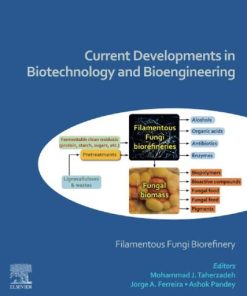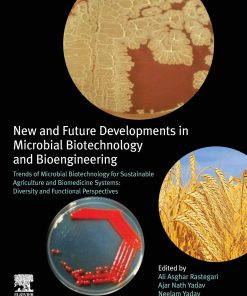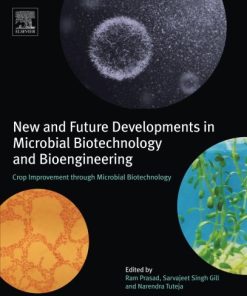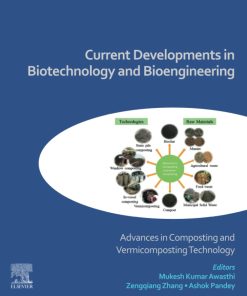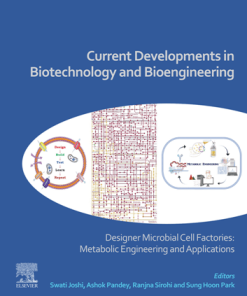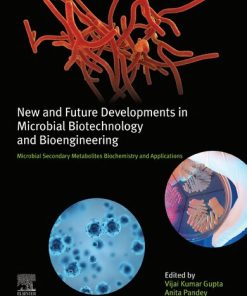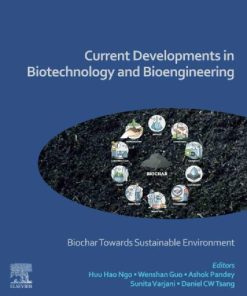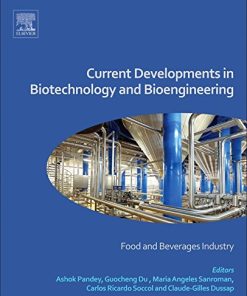(Ebook PDF) Current Developments in Biotechnology and Bioengineering Designer Microbial Cell Factories Metabolic Engineering 1st edition by Swati Joshi, Ashok Pandey, Ranjna Sirohi, Sung Hoon Park 0323885128 9780323885126 full chapters
$50.00 Original price was: $50.00.$25.00Current price is: $25.00.
Current Developments in Biotechnology and Bioengineering : Designer Microbial Cell Factories: Metabolic Engineering 1st edition by Swati Joshi, Ashok Pandey, Ranjna Sirohi, Sung Hoon Park – Ebook PDF Instant Download/DeliveryISBN: 0323885128, 9780323885126
Full download Current Developments in Biotechnology and Bioengineering : Designer Microbial Cell Factories: Metabolic Engineering 1st edition after payment
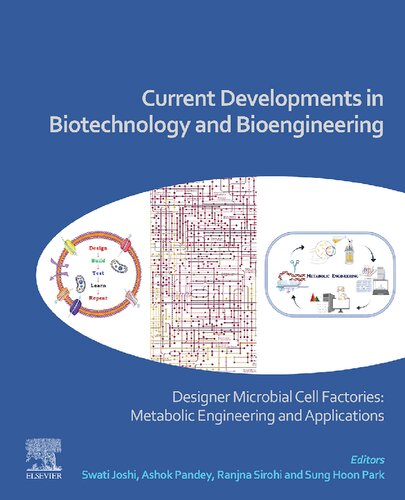
Product details:
ISBN-10 : 0323885128
ISBN-13 : 9780323885126
Author: Swati Joshi, Ashok Pandey, Ranjna Sirohi, Sung Hoon Park
Designer Microbial Cell Factories: Metabolic Engineering and Applications, the latest release in the Current Developments in Biotechnology and Bioengineering series, provides a detailed overview of the biotechnological approaches and strategies used to generate engineered microbes and to facilitate the acceleration, modulation and diversion of metabolic pathways to get desired output such as production of value-added compound or biodegradation of xenobiotic pollutant. The book also highlights applied aspects of designer microbes in fields as diverse as agriculture, pharmaceuticals and bioremediation.
Current Developments in Biotechnology and Bioengineering : Designer Microbial Cell Factories: Metabolic Engineering 1st Table of contents:
Section I: Metabolic Engineering of Cells: General and Basics
Chapter 1. Metabolic engineering: tools for pathway rewiring and value creation
Abstract
1.1 Introduction
1.2 Tools for metabolic engineering
1.3 Value generation by metabolic engineering
1.4 Conclusions and perspectives
References
Chapter 2. Membrane transport as a target for metabolic engineering
Abstract
2.1 Introduction
2.2 Membrane transport proteins
2.3 Substrate uptake
2.4 Transport from and into organelles
2.5 Product export
2.6 Cellular robustness
2.7 Substrate channeling and membrane transport
2.8 Undesired transport processes
2.9 Conclusions and perspectives
References
Chapter 3. Analysis and modeling tools of metabolic flux
Abstract
3.1 Introduction
3.2 13C-metabolic flux analysis
3.3 Constraint-based stoichiometric metabolic flux analysis
3.4 Conclusions and perspectives
References
Chapter 4. Equipped C1 chemical assimilation pathway in engineering Escherichia coli
Abstract
4.1 Introduction
4.2 Approaches for the assessment of CO2 assimilation capability
4.3 Physiological effect of RuBisCo system
4.4 Strategies to enhance the RuBisCo system
4.5 Transforming the heterotrophs to autotrophs
4.6 Prospective of RuBisCo-based chemical production
4.7 Conclusions and perspectives
References
Chapter 5. Microbial tolerance in metabolic engineering
Abstract
5.1 Introduction
5.2 Microbial stresses and responses
5.3 Strategies to improve microbial tolerance
5.4 Challenges in developing and using tolerant strains
5.5 Conclusions and perspectives
References
Chapter 6. Application of proteomics and metabolomics in microbiology research
Abstract
6.1 Introduction
6.2 Proteomics in microbiology
6.3 Metabolomics in microbiology
6.4 Conclusions and perspectives
References
Chapter 7. Approaches and tools of protein tailoring for metabolic engineering
Abstract
7.1 Introduction
7.2 Approaches for the engineering of protein
7.3 Applications of protein engineering
7.4 Conclusions and perspectives
References
Chapter 8. Microbial metabolism of aromatic pollutants: High-throughput OMICS and metabolic engineering for efficient bioremediation
Abstract
8.1 Introduction
8.2 Aromatic compounds: impact and toxicity
8.3 Microbial metabolism of aromatic compounds/pollutants
8.4 High-throughput OMICS: insights into aromatics metabolism
8.5 Metabolic engineering for efficient aromatics biodegradation
8.6 Conclusions and perspectives
Acknowledgment
References
Chapter 9. Microbial consortium engineering for the improvement of biochemicals production
Abstract
9.1 Introduction
9.2 Classification of microbial consortia
9.3 Construction of a microbial consortium
9.4 Applications of microbial consortium engineering
9.5 Recent synthetic microbial consortia and their applications
9.6 Challenges in microbial consortium engineering
9.7 Conclusions and perspectives
Acknowledgment
References
Further reading
Section II: Metabolic Engineering of Cells: Applications
Chapter 10. Metabolic engineering strategies for effective utilization of cellulosic sugars to produce value-added products
Abstract
10.1 Introduction
10.2 Sustainable carbon sources for biorefineries
10.3 Microbial cell factories for carbon source coutilization and production of value-added chemicals
10.4 Conclusions and perspectives
Acknowledgments
References
Chapter 11. Production of fine chemicals from renewable feedstocks through the engineering of artificial enzyme cascades
Abstract
11.1 Introduction
11.2 Advantages of enzyme cascades
11.3 Artificial enzyme cascades versus natural enzyme cascades
11.4 Importance of fine chemicals production from renewable feedstocks through artificial enzyme cascades
11.5 General principle of engineering of enzyme cascades
11.6 Examples of production of fine chemicals from bio-based L-phenylalanine using artificial enzyme cascades
11.7 Examples of production of fine chemicals from renewable feedstocks glucose and glycerol using artificial enzyme cascades
11.8 Conclusions and perspectives
References
Chapter 12. Metabolic engineering of microorganisms for the production of carotenoids, flavonoids, and functional polysaccharides
Abstracts
12.1 Introduction
12.2 Metabolic engineering of plant natural products
12.3 Metabolic engineering of functional polysaccharides
12.4 Conclusions and perspectives
References
Chapter 13. Bioengineering in microbial production of biobutanol from renewable resources
Abstract
13.1 Introduction
13.2 Applications and production of butanol
13.3 Biological production of butanol
13.4 Metabolic pathways of biobutanol production
13.5 Enhancement of biobutanol production
13.6 Conclusions and perspectives
Acknowledgments
References
Chapter 14. Engineered microorganisms for bioremediation
Abstract
14.1 Introduction
14.2 Types of bioremediation
14.3 Genetically engineered organisms in bioremediation
14.4 Genetic engineering techniques
14.5 Bioremediation using GEMs
14.6 Field applications of GEMs
14.7 Risk assessment of GEMs
14.8 Conclusions and perspectives
References
Chapter 15. Agricultural applications of engineered microbes
Abstract
15.1 Introduction
15.2 Agricultural applications of genetically modified microbes
15.3 Conclusions and perspectives
Acknowledgments
References
Chapter 16. Rhizosphere microbiome engineering
Abstract
16.1 Introduction
16.2 Plant-associated microbes/microbiome
16.3 Rhizosphere microbiome engineering
16.4 Emerging areas of research
16.5 Conclusions and perspectives
Acknowledgments
References
Chapter 17. Genetically engineered microbes in micro-remediation of metals from contaminated sites
Abstract
17.1 Introduction
17.2 Classification of bioremediation
17.3 Metal-contaminated sites: a problem
17.4 Genetically modified micro-organisms
17.5 Conclusions and perspectives
Acknowledgment
References
Chapter 18. Biofuel production from renewable feedstocks: Progress through metabolic engineering
Abstract
18.1 Introduction
18.2 Heterologous genetic expression in plants to improve feedstock properties
18.3 System metabolic engineering for biofuels production
18.4 Microbial production of biofuels from renewable feedstock
18.5 Challenges and techno-economic analysis of emerging biofuels
18.6 Conclusions and perspectives
Acknowledgments
References
Chapter 19. Synthetic biology and the regulatory roadmap for the commercialization of designer microbes
Abstract
19.1 Introduction
19.2 Synthetic biology
19.3 Framework of synthetic biology
19.4 Tools in synthetic biology
19.5 Applications of synthetic biology
19.6 Legal aspect of designer microbes
19.7 Regulatory challenges for the commercialization of designer microbes
19.8 Conclusions and perspectives
People also search for Current Developments in Biotechnology and Bioengineering : Designer Microbial Cell Factories: Metabolic Engineering 1st:
latest developments in biotechnology
current developments in biology
current advancements in biotechnology
new developments in biotechnology
major breakthroughs in biotechnology
Tags:
Current Developments,Biotechnology,Bioengineering,Designer Microbial,Cell Factories,Metabolic Engineering,Swati Joshi,Ashok Pandey,Ranjna Sirohi,Sung Hoon Park
You may also like…
Biology and other natural sciences - Biotechnology
Biology and other natural sciences - Biotechnology
Science (General)
Biology and other natural sciences - Biotechnology
Biology and other natural sciences - Biotechnology
Biology and other natural sciences - Biotechnology
Technique - Food Manufacturing
Current Developments in Biotechnology and Bioengineering: Food and Beverages Industry 1st Edition



